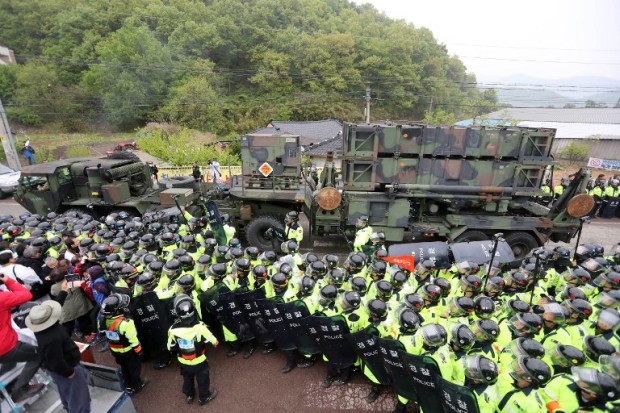US vows to force North Korea back to nuclear talks

Protesters and police stand by as trailers carrying US THAAD missile defense equipment enter a deployment site in Seongju, early on April 26, 2017. The United States pledged Wednesday to step up sanctions to force North Korea to resume dialogue over its nuclear program. AFP
WASHINGTON, United States — The United States pledged Wednesday to step up sanctions to force North Korea to resume dialogue over its nuclear program but said it was not looking to bring Kim Jong-Un’s regime to its knees.
After briefing senators at the White House, top US officials said President Donald Trump wants to use diplomatic measures and new sanctions to pressure Kim.
The president aims to “pressure North Korea into dismantling its nuclear, ballistic missile, and proliferation programs by tightening economic sanctions and pursuing diplomatic measures with our allies and regional partners,” read a statement from Pentagon chief Jim Mattis, Secretary of State Rex Tillerson and Director of National Intelligence Dan Coats.
READ: US sets up missile defense in South Korea as North shows power
“We are engaging responsible members of the international community to increase pressure on the DPRK in order to convince the regime to de-escalate and return to the path of dialogue,” the statement read, using North Korea’s official name.
Article continues after this advertisementEarlier, Admiral Harry Harris, who heads the Pacific Command, welcomed recent efforts by Beijing to defuse soaring tensions between Pyongyang and Washington, and suggested a non-military solution remained the preferred outcome.
Article continues after this advertisement“In confronting the reckless North Korean regime, it’s critical that we’re guided by a strong sense of resolve, both privately and publicly, both diplomatically and militarily,” Harris said.
“All options are on the table. We want to bring Kim Jong-Un to his senses, not to his knees.”
The latest signal from the Trump administration comes on the heel of warnings that US military action is an “option on the table” as tensions spike over a series of missile launches by the volatile North.
During a White House luncheon with UN Security Council ambassadors Monday, Trump “was very clear that he will be the president who will deal with” North Korea and that military action remains an option if China fails to rein in Pyongyang, a senior diplomat said.
National security adviser H.R. McMaster told the 15 ambassadors that “there would be a military solution even if they don’t want to do it,” the diplomat said.
The message was “ideally we do this peacefully and politically, which means through China. But if that doesn’t work, there is another plan, which is through the United States,” said the diplomat, who asked not to be named.
THAAD
Separately, a senior administration official told AFP that the United States is considering adding North Korea to its list of countries that are designated as “state sponsors of terrorism.”
Earlier Wednesday, US troops in South Korea began deploying a contentious anti-missile system in South Korea that has infuriated China.
The Terminal High Altitude Area Defense (THAAD) system is being set up on a former golf course in the southern county of Seongju, and its arrival was met by hundreds of protesters, some of whom clashed with police.
Harris said the THAAD system “will be operational in the coming days, and able to better defend South Korea against the growing North Korean threat.”
But China fears THAAD will weaken its own ballistic capabilities and says it upsets the regional security balance.
THAAD is designed to intercept and destroy short and medium-range ballistic missiles during their final phase of flight.
Harris also said the Pentagon should weigh whether to install missile interceptors on Hawaii, which could be one of the first parts of the United States in range of an improved North Korean missile, in addition to existing interceptors in California and Alaska.
‘Rain of fire’
Pentagon officials have stressed to Trump there are no easy options for military interventions in North Korea.
Washington has deployed an aircraft carrier strike group to the peninsula in a show of force, amid signs the North could be preparing for a sixth nuclear test.
The deployment drew widespread derision after it emerged that instead of steaming toward the peninsula, the ships actually headed in the opposite direction for a few days to train with the Australian navy.
“That’s my fault on the confusion and I’ll take the hit for it,” Harris said.
Harris said the USS Carl Vinson strike group is now in the Philippine Sea just east of Okinawa, “in striking range and power projection range of North Korea if called upon to do that.”
In Pyongyang’s latest display of its military capabilities, Kim oversaw the country’s largest-ever firing drill to mark the founding anniversary of its military, state-run media said Wednesday.
Seoul held a large annual drill of its own, involving some 100 artillery pieces, 90 armored vehicles and 50 aircraft, as well as 2,000 South Korean and US troops, the defense ministry said. CBB